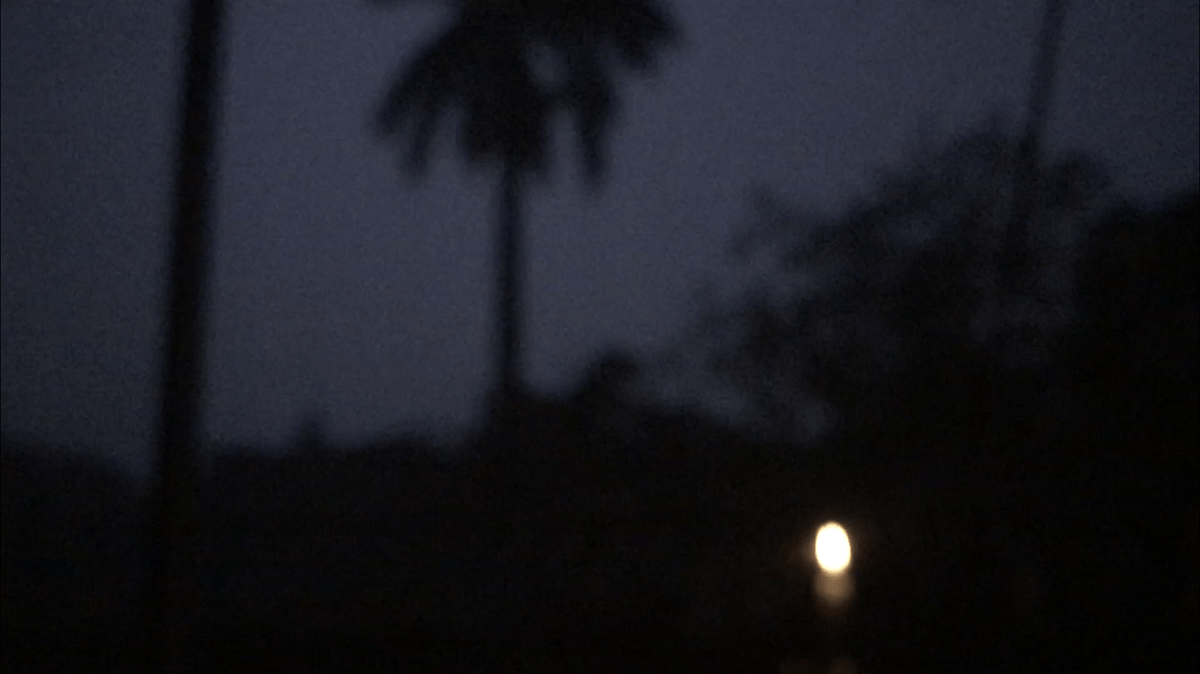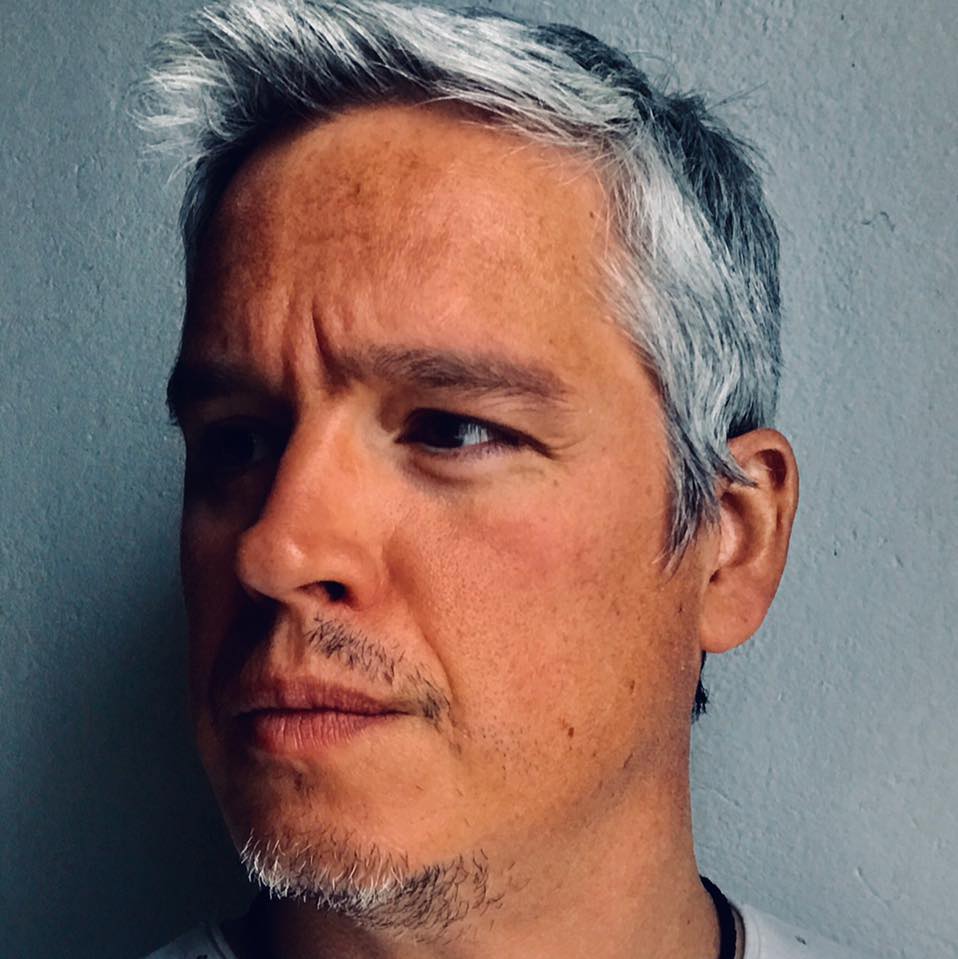Ride the lightning
I took this picture last night, just minutes after an overwhelming draft started to violently shake all the trees in the neighborhood and the lights of the city went off. It was taken from my bedroom window, on the second floor of my house, in the midst of the heavy rainstorm that battered Asunción and most of central Paraguay.
The egg-shaped point of light is the flame of a candle I had just lit. The blurred, porous background is populated by darkened rooftops and the ghostly movements of desperate foliage. Suddenly visible by a flash of lightning, an octopus-like palm tree catches my eye. Two opaque lines, the window frame and the cord that pulls up the curtain, add to the strange landscape of shadows.
This morning, the city looked ravaged. Streets blocked by old trees torn down by the storm, thousands of homes without electricity, damage of buildings and infrastructure. Reports of casualties start to come out.
Although it all sounds like a rare natural phenomenon that hit an population unsuspectedly, these conspicuous storms are quite frequent in Paraguay, especially at this time of the year, during the so-called “rain season”. News outlets spare no headline expense in conveying the human drama caused by these tempests, yet most of the time they fail to relate them to patterns which point to a story of a greater scale.
Just a few weeks ago, the situation was the absolute opposite. We were suffering the longest drought in fifty years, along with thousands of wildfires that set the map ablaze.
Extremes are becoming the normal. And yet, society seems unable or unwilling to connect the dots.
There is a known and amply researched causal correlation between deforestation and climate change. The unrelenting, zombie-like behavior of clearing the vegetal mass on earth is a major contributor in altering a fragile and exquisite equilibrium – most crucially, the steadiness of a certain range of temperature – that allows for all current forms of life to be here in the first place.
Paraguay, along with neighbors Brazil, Bolivia and Argentina, is one of the countries with the highest rates of deforestation in the world, so the possibility that extremes in weather patterns are natural responses to our extreme behavior should not be all that surprising.
Perhaps we can change our behavior in time. Or, perhaps, we have already messed with that gentle equilibrium beyond a phantom mark, and the way earth will eventually balance itself once again has to do with us not being here anymore. I can’t help but find a certain poetic association in the latter prospect. Like the palm tree in the picture, we appear briefly on earth’s life scene, and just as quickly, the same lightning that made us visible turns us off.
Reite auf dem Blitz
Ich habe dieses Bild letzte Nacht gemacht – nur wenige Minuten nachdem ein starker Sturm angefangen hatte, die Bäume in der Nachbarschaft gewaltig durchzuschütteln, und die Lichter der Stadt ausgegangen waren. Aufgenommen wurde es von meinem Schlafzimmerfenster im zweiten Stock meines Hauses und inmitten des heftigen Regenschauers, der Asunción und den größten Teil Zentralparaguays traf.
Der eiförmige Lichtpunkt ist die Flamme einer Kerze, die ich gerade angezündet hatte. Der verschwommene, grobkörnige Hintergrund wird von finsteren Dächern und den gespenstischen Bewegungen verzweifelter Blätter bevölkert. Plötzlich durch einen Blitz sichtbar, fällt mir eine krakenartige Palme ins Auge. Zwei dunkle Linien, der Fensterrahmen und die Schnur, die den Vorhang hochzieht, tragen zu der seltsamen Schattenlandschaft bei.
Heute Morgen sah die Stadt verwüstet aus. Straßen wurden durch alte Bäume blockiert, die der Sturm umgeworfen hatte. Tausende Häuser ohne Strom. Schäden an Gebäude und Infrastruktur. Nach und nach gibt es Berichte über Verletzte.
Das klingt nach einem seltenen Naturphänomen, das die Bevölkerung unerwartet traf. Tatsächlich sind solche Stürme in Paraguay recht häufig – besonders jetzt, in der sogenannten „Regenzeit“. Die Medien tun alles für Schlagzeilen zu menschlichen Dramen, die diese Unwetter auslösen. Doch sie zeigen meist nicht die Muster dahinter, die auf eine viel größere Geschichte hindeuten.
Noch vor wenigen Wochen war die Situation das genaue Gegenteil. Wir litten unter der längsten Dürre seit fünfzig Jahren und Tausenden Waldbränden, die alles heimsuchten.
Extreme werden zur Normalität. Und doch scheint die Gesellschaft unfähig oder nicht willens, Zusammenhänge zu erkennen.
Es gibt einen bekannten und gut erforschten kausalen Zusammenhang zwischen Abholzung und Klimawandel. Die unerbittliche, zombiehafte Art, die üppige Vegetation der Erde zu beseitigen, trägt ganz wesentlich dazu bei, ein fragiles und feines Gleichgewicht zu verändern. Es ist besonders wichtig, dass die Temperatur in einem bestimmten stabilen Bereich bleibt. Dieses Gleichgewicht ist die Basis für alle aktuellen Lebensformen.
Paraguay ist zusammen mit seinen Nachbarn Brasilien, Bolivien und Argentinien eines der Länder mit der meisten Abholzung weltweit. Die Möglichkeit, dass das extreme Wetter eine natürliche Reaktion auf unser extremes Verhalten ist, sollte also nicht überraschen.
Vielleicht können wir unser Verhalten noch rechtzeitig ändern. Vielleicht haben wir dieses sanfte Gleichgewicht aber auch schon zu sehr gestört und die Erde wird es möglicherweise nur wiederfinden, wenn wir nicht mehr da sind. Ich kann nicht anders, als mit der letzten Perspektive etwas Poetisches zu assoziieren. Wie die Palme auf dem Bild erscheinen wir kurz in der Lebensszene der Erde. Und genauso schnell schaltet uns derselbe Blitz aus, der uns sichtbar gemacht hat.
Übersetzung: Iris Thalhammer
Al filo del relámpago
Tomé esta foto anoche, pocos minutos después de que una abrumador vendaval comenzara a sacudir violentamente todos los árboles del vecindario y las luces de la ciudad se apagaran. La tomé desde la ventana de mi dormitorio, en el segundo piso de mi casa, en medio de una flerte tormenta que azotó Asunción y la mayor parte del centro de Paraguay.
El punto de luz con forma de huevo es la llama de una vela que acababa de encender. El trasfondo turbio y poroso está poblado por tejados oscurecidos y por los movimientos fantasmales de um follaje desesperado. De repente, visible por el flash de un relámpago, una palmera con forma de pulpo me llamó la atención. Dos líneas opacas, el marco de la ventana y el cordón que corre la cortina, se suman a ese extraño paisaje de sombras.
Esta mañana, la ciudad parecía devastada. Calles bloqueadas por viejos árboles derribados por el viento, miles de casas sin electricidad, daños estructurales en viviendas, edificios e infraestructura pública. Empiezan a salir informes sobre víctimas.
Si bien todo esto suena como un raro fenómeno natural que súbitamente golpea a una población insospechada, estas conspicuas tormentas son bastante frecuentes en Paraguay, especialmente en esta época del año, durante la llamada “temporada de lluvias”. Los medios de comunicación no escatiman titulares que relatan el drama humano causado por estas tempestades, pero la mayoría de las veces no las relacionan con patrones que apuntan a una historia de escala mayor.
Hace apenas unas semanas, la situación era todo lo contrario. Sufríamos la sequía más larga em cincuenta años, además de miles de incendios forestales que encendían el mapa.
Los extremos se están convirtiendo en lo normal. Y, sin embargo, la sociedad parece incapaz o reacia a atar cabos.
Existe una correlación causal conocida y ampliamente investigada entre la deforestación y el cambio climático. Ese irrefrenable comportamiento tipo zombi de cargarse con la masa vegetal de la tierra es un factor importante en la alteración de un equilibrio frágil y exquisito — la estabilidad de un cierto rango de temperatura — que permite que todas las actuales formas de vida estén aquí en primera instancia.
Paraguay, junto con sus vecinos Brasil, Bolivia y Argentina, es uno de los países con las tasas de deforestación más altas del mundo, por lo que la posibilidad de que los patrones climáticos extremos sean respuestas naturales a nuestro comportamiento extremo no debería ser tan sorprendente.
Quizás podamos cambiar nuestro comportamiento a tiempo. O, tal vez, ya hemos arruinado esse delicado equilibrio más allá de un límite fantasma, y la forma en que la tierra finalmente se equilibrará una vez más tiene que ver con que ya no estemos aquí. No puedo evitar encontrar una cierta asociación poética en esta última perspectiva. Al igual que la palmera de la imagen, aparecemos brevemente en la escena de la vida de la tierra y, con la misma rapidez, el próprio rayo que nos hizo visibles, nos apaga.
(Traducido del inglés por el autor)
Teilen












